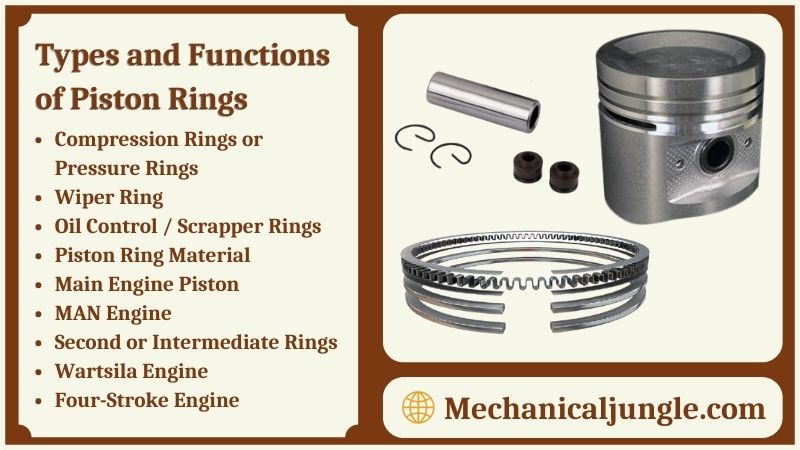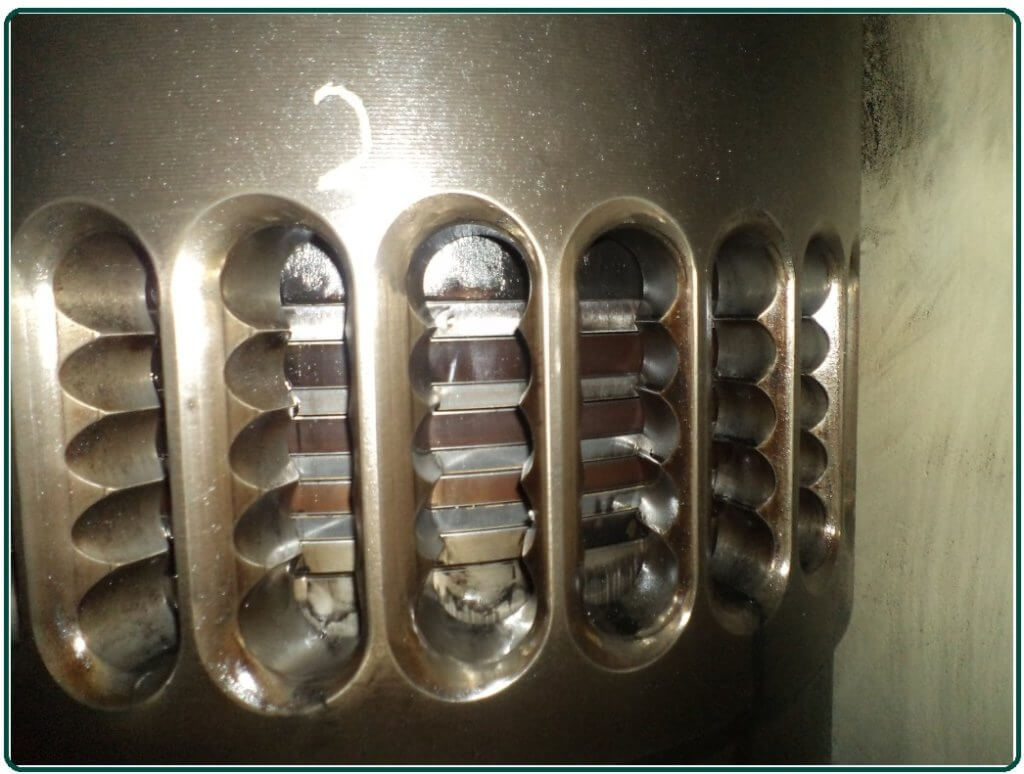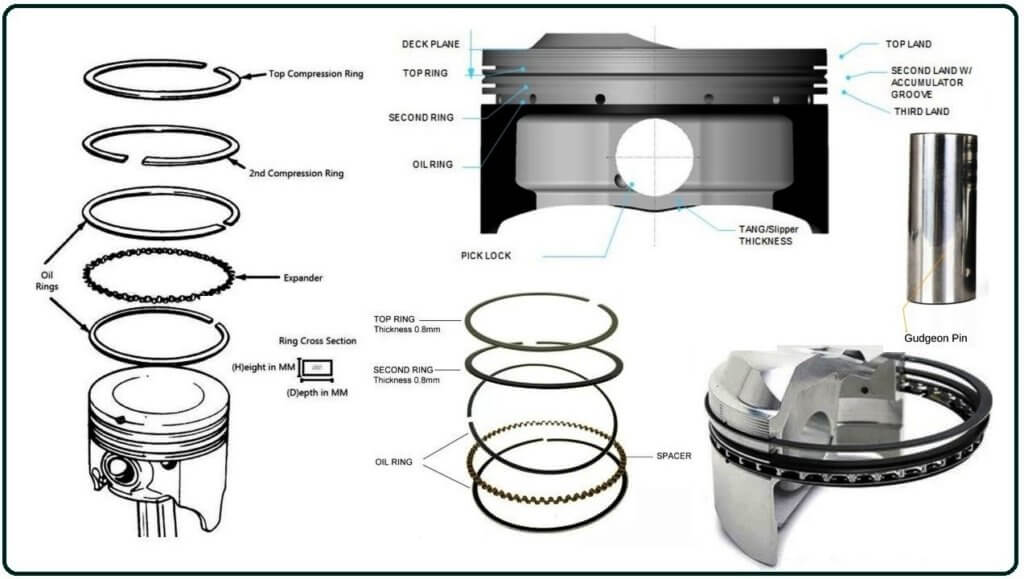
What Is Piston Ring?

Simply put, the piston rings form a seal between the piston and the cylinders wall, which prevents pressurized combustion gases from entering the oils sumps.
They also control oil consumption by preventing excessive oil from entering the combustion chamber and burning. Properly functioning rings are critical for maximum engine power and efficiency.
What Do Piston Rings Do?
Most stocks of automotive pistons have three rings, as shown here on these new automotive pistons. The top and other rings are responsible for pressing tightly against the cylinder wall & sealing the combustion chambers, keeping combustion gases in & oil out.
The oil ring extracts oil from the cylinder wall on its way down the cylinder, depositing it back into the oil sump. Since an extremely thin film of oil lubricates the ring/cylinder wall interface, it is normal for some oil to burn during combustion. However, “normal” oil consumption depends on the engine.
How Is Piston Ring Installation Done?
Before the piston ring is installed, the new or spare rings are checked for their marking & compared with the old ones for the same grades or condition.
If the old piston ring marking is erased, check the manual for identification of the piston rings so that they can be placed in their appropriate groove. The drain must be properly cleaned to ensure that no carbon and sludge accumulates in it.
When cleaning, it should be borne in mind that some piston grooves are coated with special protective films. They should not be damaged by used chipping or grinding tools.
Once the grooves are properly cleaned, the piston rings are installed using a piston ring tool, which expands the ring to slide over the piston head and inserts it into the groove.
Be sure to place the ring with the marking facing up. Most piston rings are provided with a “Top” marking or identification number when no specific marking is present. The stamped surface is considered the top face.
Proper use of the ring expander tool is extremely important because incorrect use can damage the ring or cause injury to the operator as the ring is under constant tension.
In smaller four-stroke engines, if the equipment is not available, the ring can be expanded using cloth or rags available in the engine room.
Two rags are placed on either side of the ring, and they are pulled so that the rings can be extended and inserted over the piston. After fitting all piston rings, ensure that the opening or butt ends of all piston rings are not aligned to avoid gas leakages from the chamber.
Types and Functions of Piston Rings:
#1. Compression Rings or Pressure Rings

Compression rings provide sealing over the piston and prevent gas leakage from the combustion side. Compression rings are located in the first groove of the piston. However, this may vary accords to the design of the engines.
The primary functions of these rings are to seals the combustion gases & transfer heat from the piston to the piston walls.
The layer of oils lefts by the oil ring is controlled by shear; thus, the top compression rings provide adequate lubrication. In addition, it also aids in sealing and heat transfer to the top compression ring.
#2. Wiper Ring

The wiper ring is also called the Napier ring, or the backup compression ring is installed under the compression ring. Their main functions are to clean the liner’s surface from excess oil and to act as a support backup ring preventing any gas leakage that has escaped from the top compression ring.
Most wiper rings have a taper angle face located at the bottom to provide wiping action as the piston moves toward the crankshaft.
If the wiper ring is incorrectly installed with the tapering angle closest to the compression rings, it results in excessive oils consumption. This is caused by the wiper ring wipings away excess oil towards the combustion chamber.
#3. Oil Control / Scrapper Rings
Oil control rings control the amounts of lubricating oils passing over or under the cylinder walls. This ring is also used to spread the oil evenly around the perimeter of the liner. Oil is sprayed on the cylinder walls.
These rings are also called scraper rings because they remove the oil from the cylinder walls and send it back to the crankcase.
These rings do not allow oils to pass through the space between the ring face and the cylinder. In the oil ring, a hole or slot is cut in the radial center of the ring that allows excess oil to flow back into the reservoir. Oil rings can be one-piece or two-piece.
In order to increase the contact pressure between the ring and the liner surface, the rings may be placed at the outer edges of the ground or facing the combustion chamber to reduce oil consumption through better oil scraping from the bore.
The two-piece oil control ring consists of a cast iron or profile steel ring and a coil spring made of heat-resistant spring steel to act around the entire ring circumference to maintain pressure and contact.
#4. Piston Ring Material
One of the most prominent materials used in maks pistons rings is cast iron. This is because it contains graphite in a lamellar form which acts as a self-lubricant that aids in the sliding motion between the rings and the liner.
Alloys and coatings are made on piston rings, and this will vary by type of ring as the functionality of these rings differs from one another.
The most common forms of the alloy are chromium, molybdenum, vanadium, titanium, nickel, & copper. The piston ring materials are kept harder than the cylinder liner to provide maximum life.
#5. Main Engine Piston
The combustion chamber of two strokes marine engines is a large space producing a significant amount of heat and stress.
The upper rings of the piston are in direct contact with the combustion chamber, so they require better protection and coating to cope with thermal stress and provide proper sealing.
Several new designs were introduced, especially for large two-stroke marine engines. Some of the important designs offered are:
#6. MAN Engine
The upper piston ring is of controlled pressure relief type with several slanted shallow grooves (hard chrome plated) on the face, which allows some gas pressure to pass through the second ring, reducing the load on the top ring. It has an ‘S’ type joint at the ends of the ring.
New designs were also recently introduced, which are modified versions of CPR rings known as CPR Ports on Plain Rings (CPR POP).
The modifications are done on the positions of the groove, which is now placed at the bottom of the ring, as it was noted that the wear of the groove on the running side of the CPR ring was faster than usual.
#7. Second or Intermediate Rings
Other rings have a slant cut at the ends of the ring. All piston rings are aluminum-coated on the outer surface to help with running in.
#8. Wartsila Engine
In the Wartsila 2-stroke engine, the pistons ring grooves on the piston surface are hardened for excellent wear resistance. The top piston ring (also known as the Gas Tight (GT) ring in Wartsila) has overlapping ends to avoid gas leakages with an asymmetrical barrel shape.
They are chromium-ceramic (CC) coated with an ongoing coating (RC). The number of piston rings will vary depending on the size of the engine. The Flex 35 will have a much shorter skirt and will be equipped with three piston rings, but an RTA engine can have up to 5 piston rings.3
#9. Four-Stroke Engine
The piston ring requirement in a four-stroke engine is different because the piston liner assembly is open to the sump. Therefore, there is an additional need for oil scraper rings in 4-stroke piston ring packs. It usually has 2-5 rings depending on the type and specification of the engine.
Typically, 2-4 compression rings are provided to seal gases from the combustion chamber, and 1-3 oil-control rings are provided to avoid oil entering the combustion chamber.
Compressor rings are typically barrel-type with a tapered face for efficient gas sealing. The oil-control ring profile includes two ground and an included coil spring to support the pre-tensioning of the ring.
How Do Piston Rings Work?
As explained, different types of rings are provided at different levels in the piston, which perform different functions. The top groove of the piston has a compression ring whose main function is to seal any leaks inside the combustion chamber during the combustion process.
When the air-fuel mixture is ignited, the pressure of the combustion gases is applied to the piston head, causing the piston to move toward the crankshafts. Pressurized gases pass-throughs the gaps between the cylinder wall & the piston into the piston ring groove.
During the combustion process, the force of the high-pressure gases presses the piston ring against the wall of the cylinder liner, which helps it to create an effective sealing. This pressure pushing the piston’s rings is proportional to the pressure of the combustion gas.
The next set of rings in the pistons, which is placed below the compression ring and above the oil rings, is called the wiper ring. They have a tapered face construction & are used to further seal the combustion chamber.
As the name suggests, they aid in cleaning the liner wall of any excess oil and impurities. If any combustion gases were able to pass through the compression ring, these gases would be blocked by the wiper’s rings in good condition.
The last sets of rings are oil rings located in the lower groove of the piston closest to the crankcases. The main function of the oils ring is to remove any excess oil from the cylinder liner walls when the pistons are in motion.
The majority of the wiped oils are directed back into the crankcase into the oil sump. These oil rings come with a rear-mounted spring in 4-stroke engines to provide an extra push to wipe the liner.
Things to Check During Piston Ring Inspection:
Inspection of piston rings is an important task to determine the proper function of piston rings, followed by cleaning or replacing piston rings (if broken or worn).
In a 2-stroke bicycle engine, the port on the top ring is usually in a higher position than the top ring groove on a 4-stroke engine.
During Routine Inspection:
During a normal scavenging site inspection, the piston rings are depressurized with the help of a screwdriver. This is done to check the spring actions or tensions of the rings. It also shows whether the ring is broken or not. If the ring breaks, there will be no spring action.
The rings are checked for their freedom in the grooves, as they can get stuck due to carbon deposits and eventually cause great damage to the liner.
The clearance between the ring & the groove is also checked, and the wears are calculated. The ring is checked for scratches & damage, and the overall condition is also assessed.
Why Do Piston Rings Fail?
The combustion chamber exerts excessive pressure on the piston rings. If the combustion pressure of the generated gas inside the chamber is higher than normal, it may affect the performance of the ring.
This can be caused by the explosion and pinging of fuel from a leaky injector or when the fuels are mixed with dirty air.
Contaminated fuels oils or the wrongs grade of cylinder oil will also affect the performance of the ring. As the ring begins to wear out, its ability to seal the combustion gases becomes apparent.
Poor fuel or cylinder oil quality, poor combustion process, wrong fuel timing, worn liners, etc., are common reasons for worn piston rings.
The most common sign or sign of a worn-out ring is gas passing into the crankcase or under the piston area, known as a blobby. Viscous rings due to carbon or sludge deposits and wear down due to cracks or cracks on the ring may result.
During Major Overhaul:
During major overhauls, the piston rings are completely replaced with new sets. Buts the following steps need to be considered for scraping the rings:-
- If the piston ring is found stuck in the groove.
- If the axial heights of the rings are reduced & the clearances in the rings and groove are large.
- If the chrome layer is chipped or damaged.
During the overhaul, the groove must be properly cleaned of carbon deposits and checked for damage in the ring groove. Before applying piston rings, they must first be rolled into the groove.
In this process, the ring goes completely inside the groove. From this test, we can check that the grooves are deeper than the radial width of the ring.
When inserting pistons with replaced rings in the liner, use a piston ring compressor tool sufficiently lubricated to ensure that the ring will not stick to the face of the liner as it moves inside the combustion chamber.
Piston rings are placed inside the worn liner, and the butt gap is also checked. For small pistons such as compressor rings, the ends can be treated using a piston ring filer, but for marine engines, the rings must be sent to a shore workshop for repair if the butt gap is abnormal.
While affixing the rings, it should be checked which part is above or below and also check different markings for different posts. The rings should be fitted with the help of proper toll, i.e., with the help of a ring expander.
The clearance between the ring & the grooves is checked with the bit’s help of a feeler gauge. The axial and radial clearances of the old rings are checked & recorded to assess the amount of wear over several hours.
Frequently asked questions (FAQs) that you can include in your article about piston rings:
What are piston rings and what do they do?
Piston rings are circular bands fitted around the piston that seal the combustion chamber, control oil consumption, and aid in heat transfer.
How many types of piston rings are there?
Piston rings are mainly categorized into compression rings, wiper rings, and oil control rings, each serving different functions.
What materials are piston rings made of?
Piston rings are typically made from cast iron with various alloy coatings like chromium, molybdenum, and others to enhance durability and performance.
How are piston rings installed?
Installation involves cleaning piston grooves, checking ring orientation, and using tools like ring expanders to safely fit the rings into place.
What are common signs of worn piston rings?
Signs include increased oil consumption, loss of engine power, blue smoke from the exhaust, and pressure leaks in the crankcase.
How often should piston rings be inspected or replaced?
Piston rings should be inspected during regular engine maintenance and replaced if wear or damage is detected, typically during major overhauls.
What causes piston rings to fail?
Failure can result from excessive engine heat, poor lubrication, contamination, or improper installation, leading to reduced sealing and performance.
Can piston rings be reused after removal?
It’s generally recommended to replace piston rings with new ones during engine reassembly to ensure optimal performance and sealing.
What tools are needed for piston ring replacement?
Tools include ring compressors, ring expanders, feeler gauges, and cleaning brushes to facilitate safe and effective ring installation.
How do piston rings contribute to engine efficiency?
By maintaining proper compression, reducing oil consumption, and facilitating efficient heat transfer, piston rings play a crucial role in maximizing engine power and fuel efficiency.

